“Yank” Bert Levy
by
Phil MatthewsPart One
The Combatives Freedom Fighter
Born: 5/10/1897
Died: 2/9/1965
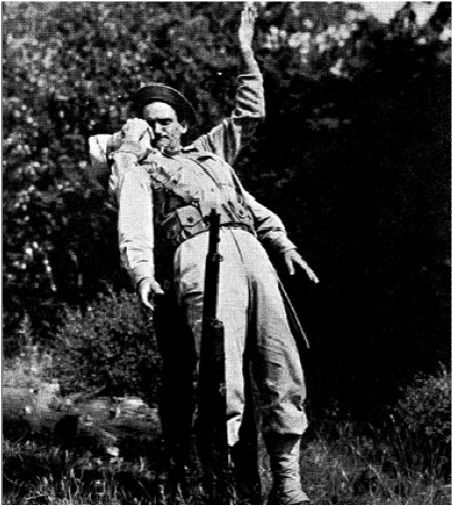
Levy Sentry Removal Technique – NARA
"Yank" Levy was by far one of the most interesting characters of the war to instruct Allied Troops in Close Combat techniques. This short article attempts to give a brief overview of some of the biographical details that have been found. If anyone has more information they can contribute please feel free to contact me, as always this is a
work in progress.
© thebristolbloke 2006
Introduction A Jewish Canadian by birth Bert Levy was born in the city of Hamilton in Ontario, Canada on the 5of October, 1897. His parents moved to Cleveland, Ohio in the United States when he was three months old and he appeared to have the normal schooling of an American child of the time. Although Levy’s father Sam was a chauffeur and printer at age eighteen young Levy joined the Merchant Navy and travelled the world as an engine stoker. The year was 1916, after working for approximately a year he arrived in Palestine where he disembarked and joined the 39Battalion, Royal Fusiliers. There is some debate that Levy fought with the Jewish Legion in Palestine but on this my findings are unclear, I’d love to know more.
Levy fought with the Fusiliers from 1918 to 1919 throughout Palestine and Jordan. It is likely that it was there that he first learned of one of his later hero’s, the celebrated British guerrilla fighter T.E Lawrence (most commonly known as “Lawrence of Arabia”).
Guerrilla warfare was at that time something of an unknown (and often despised) quantity amongst the Army of the British Empire. It went totally against the ‘rules of war’ they adhered too.
Against overwhelming and formidable odds from Turkish and German troops Lawrence managed to raise a guerrilla band of Arab tribesmen who harried raided, ambushed and sabotaged that enemy occupied country out of all proportion to their few numbers. Lawrence later wrote a book which he entitled “Seven Pillars of Wisdom”
(recommended reading) about these exploits, from his being in that area at the time I cannot help but feel that the spirit and tactics captivated the young Levy.
As soon as his duties with the Fusiliers had finished he made his way back to America, filled with youthful enthusiasm he travelled and was involved in a lot of adventures (and mis-adventures) in Central and Southern America.
In the 1920's and 30's he was breaking Government blockades as a gun runner and a soldier of fortune in such countries as Nicaragua and Mexico. Some of his experiences he later put to pen in order to aid others but in this I’m getting ahead of myself.
The 1920’s were a time of youthful optimism to an international generation which had experienced the horrors of the First World War. Revolution in the South American states was endemic and there were many opportunities for the adventurous and idealistic of the time.
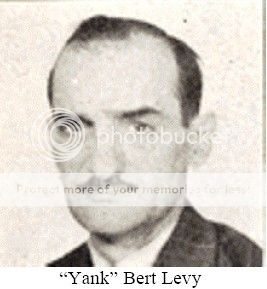 “Yank” Bert Levy
“Yank” Bert Levy Narrowly escaping death on a number of occasions Levy returned to the United States, unfortunately as happens with many impressionable young men he fell in with “the wrong crowd”. Deported from the US after serving six years in prison for armed robbery (something in his life he would always regret) the older and wiser Levy took to travelling and next made his appearance in Spain in the late 1930’s. The decade is best remembered for its period of huge financial insecurity and loss, best known in the United States as “The Depression” it had far reaching implications for the rest of the world.
Extreme politics have a habit of developing in such trying times; this was true of Germany and also in Spain. A Military coup by the Spanish Army sparked a massive civil war as the population fractioned into right against left wing. The Fascist right wing faction was headed by an officer named General Franco who tried to set himself
up as a Nationalist Dictator. The opposing left wing was a side composed of nominal Spanish communists and a rag tag bag of nationals, intellectuals and, more importantly for us -the Internationals.
Inspired by the war against fascist tyranny many young men from countries all over the world had heard the cry for help and responded. Not only was this a battle against a Dictator backed by the German Nazi leader Adolf Hitler it was felt it was the “thin edge of the wedge” against it’s doctrines spreading to the rest of the world.
At that time Italy was run by the Fascist Dictator Benito Mussolini and even in Britain the British Union of Fascists run by Oswald Mosley was gaining in support and membership.
It was a time of hope and idealism; many had thought the absolute nightmare of the First World War had done away with the peoples need for war. In latter times however others would say that the war in Spain was a direct warning that the world should have been heeded more closely to the rise of Fascism.
The International Brigades were formed from volunteers from many countries, individuals who had not only travelled to Spain from their respective countries but managed to make it through the lines.
As an English speaker Levy managed to join the British Company of the Internationals, here he distinguished himself via his prior experience in war. Becoming an officer in the British Machine Gun Battalion he gained his lifelong
nickname of “Yank”. Involved with many of those in the fight he also found himself meeting someone who would later change his life totally, a man by the name of Thomas Wintringham who was his battalion commander.
After just over a year of fighting Levy was captured after he was wounded in the battle at Jarama. He spent the next six months of his life as a Prisoner of War in a horrific camp; luckily for him the Canadian Government raised mighty protests at his treatment and arranged for him to be released. As soon as he had regained his health he tried to return to the fighting in Spain. All too soon though the resistance there was crushed.
Despite the bravery and heroism of the Spanish freedom fighters and the International Brigades that cause was lost.
The War Years The War with Nazi Germany was looming and some concerned persons who had experienced their brutalility first hand were planning. Tom Wintringham was a Communist who had friends in high places, in 1939 and early 1940 he set about planning a school for guerrilla warfare to teach others to resist the Nazi Invader. At a property ‘donated’ by the estate of the then Earl of Jersey and financed by a Mr Edward Hulton (Owner of the ‘Picture Post’) the “Osterley Park School for the Home Guard” Training Centre opened in June 1940.
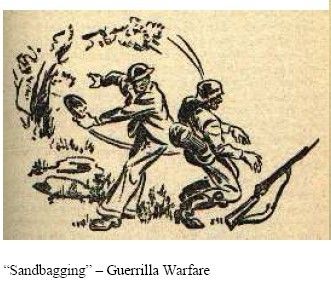 “Sandbagging” – Guerrilla Warfare Levy
“Sandbagging” – Guerrilla Warfare Levy Just as SOE learned, finding Instructors with relevant knowledge was a hard thing. Wintringham had from his days with the International brigades known many people with direct experience of Guerrilla Warfare, most however were dead or in Spanish prisons
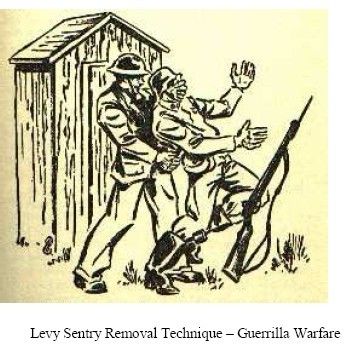 Sentry Removal Technique – Guerrilla Warfare
Sentry Removal Technique – Guerrilla Warfare Of the remaining veterans three Spanish ex-miners (who had a great knowledge of using explosives against Tanks, Troops and buildings) were signed up.
The majority of the remainder of the Instructors were also veterans of the Spanish Civil War, however they were so short staffed at Osterley at one point that Boy Scouts were employed to show how to setup wire ambushes across roads to decapitate Enemy Motorcyclists!
Highly skilled and knowledgeable the Instructors may have been the fact that they had fought in the Spanish Civil War was ultimately the Schools undoing despite its massive popularity.
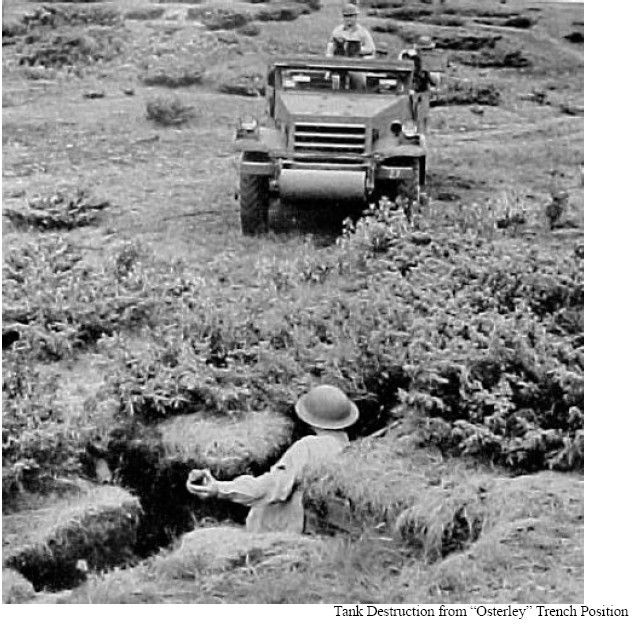 . Tank Destruction from “Osterley ”Trench Position
. Tank Destruction from “Osterley ”Trench PositionThe school was in operation from June until September 1940, it was then taken over by the War Office and later in October moved to another location.
The training was run over the weekends (Sat/Sun) so the Home Guard members didn't have to run the problems getting time off their work. I have found this to be the case for the majority of Home Guard and even Aux Unit training courses. The difference here is the attendance figures. I’ve never been good at mathematics but bear with me here. According to the noted Home Guard researcher David Caroll “nearly five thousand officers and men from the Home Guard” (who were attending courses lasting only two days) “benefited from the instructors” -“personal experience and expertise”. Here’s the math (for the mathematically illiterate like me) 3 months equates to approximately 12 weekends (approx) 5000 trainees divided by 12 weekend equals 416.6 trainees per weekend (approx)
According to Charles Graves in his official account of the Home Guard the total was 4, 940 – this leaves us with a total of 411.6 trainees per weekend. Either way that means that over 400 members of the Home Guard (and others) were turning up for each weekend course offered by the Osterley staff. If you consider that this was at a time when travel wasn’t as widespread as it is now, where petrol rationing was in force and the people attending were engaged on essential war work the majority of the time it really is staggering!
The War Office and the “Establishment” saw this and were worried, the popularity of the training school showed just how much interest there was in the subject and how little ‘official’ training was going on.
They did what they usually do in such cases, ‘if you can’t destroy its credibility then absorb it, make it part of the establishment’. It was taken over “for the duration”, Tom Wintringham was out -the Spanish miners were still there but the War Office had made a Lieutenant Col Pollock Commanding Officer. Other Instructors who were found to not be reliable (politically -because they were of left wing backgrounds) were quietly removed also.
Levy had only taught at the school for one month but the War Office recognised his great knowledge and depth of practical experience and kept him on, teaching at the War Office No.1 School and other places.
Levy had been employed at Osterley as a ‘jobbing’ Instructor, that is to say he had a wide range of skills and could lecture on many subjects of Guerrilla Warfare.
Covering for any shortage or gap in instruction his main lecturing subject was however “Knife Fighting” and “Hand to Hand Combat”.
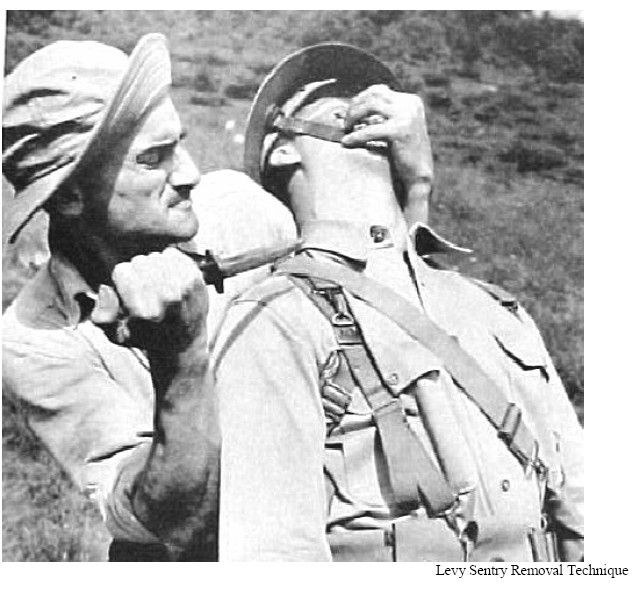 Levy Sentry Removal Technique Going Alone
Levy Sentry Removal Technique Going Alone After training the British Home Guard for around fifteen months after the Osterley School had closed, Levy was then officially “lent” by the War Office to the United States Army. The fact that the US Government “overlooked” the fact he had been convicted and deported shows again just how short they were of experienced instructors. As one newspaper wrote “He was so good at his "art" that the United States brought him here from England during WW2 as an instructor, despite the fact that he had been deported in 1933 after serving six years for armed robbery.
Levy was a man who couldn’t waste his time; he also had little time for the people who had treated his ‘comrades’ in arms’ so badly. In his time in England training the Home Guard he had written his master piece on Guerrilla Warfare which had a forward from Tom Wintringham. Published by Penguin in the United Kingdom and by a joint collaboration between Penguin and the Infantry Journal in the United States Levy spent the remainder of his War Instruction on a lecture circuit. He trained many soldiers, sailors and civilians in the subjects he know so well. He also made the cover of many American magazines including Life Magazine in 1942.
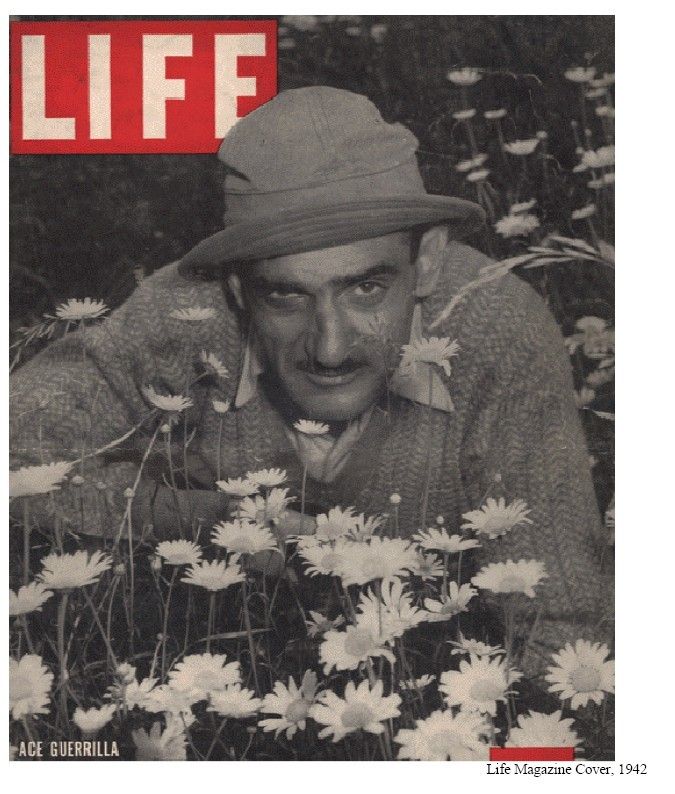 Life Magazine Cover, 1942
Life Magazine Cover, 1942 Levy updated his book on Guerrilla Warfare several times until his death. I have two of the editions (the 1941 United Kingdom and United States versions), other updated versions were written. If you can get a cheap copy of his book I recommend it, it's a great work written by someone who really researched his craft. It also gives a good insight as to how desperate Britain was back then. If anyone else has a version I don’t have and they want to e-mail which edition they've got maybe we can work out how many they made and what differences there are.
Levy was teaching his methods of close quarter combat in isolation from other instructors from that time as far as I have been able to discover. As I’ve already explained I’d love to know more.
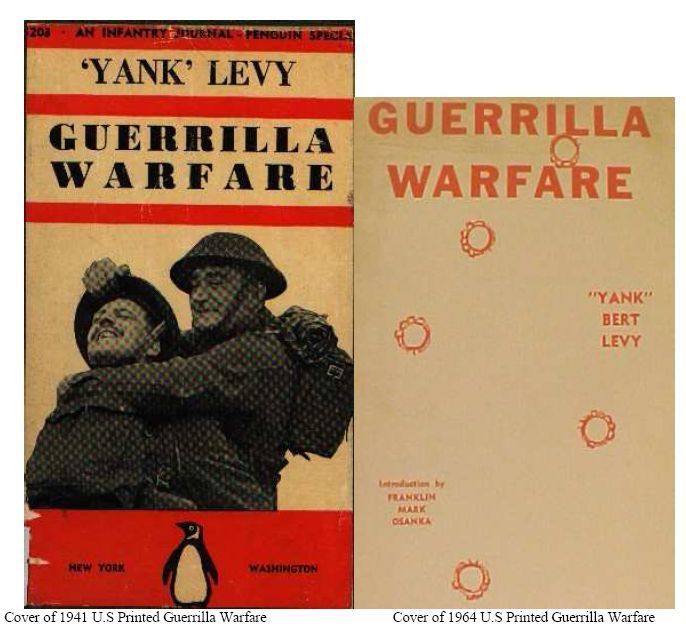 Coverof1941U.S Printed Guerrilla Warfare Cover of 1964U.S Printed GuerrillaWarfare
Coverof1941U.S Printed Guerrilla Warfare Cover of 1964U.S Printed GuerrillaWarfareThe book he wrote was first published by Penguin in Britain and then in the US in a joint venture with the publishing company Infantry Journal. The latter edition was more illustrated than the original but the text remained the same. There are some leads to suggest that it was privately reprinted again in 1954 but the next generally available
reprint was in 1964 by the fledgling “Panther Publications”. The Vietnam War had just begun, as a result the US radical and civil disobedient movements also began.
Guerrilla Warfare had a new reader base by both soldier and civilian again. A new introduction was added by the author of “Modern Guerrilla Warfare” Franklin Mark Osanka. Osanka was an expert in techniques of fighting Communist Guerrilla Movements, Panther were later renamed ‘Paladin Press’ and the book was a high seller for many years. Levy was a very interesting man and left a long legacy.
At the age of 67 after suffering from illness “Yank” Bert Levy died on the 9th of February 1965. He was survived by his wife Mary and daughter Rose. If anyone can put me in contact with them please contact me.
Bibliography Yank Levy -Guerrilla Warfare (various Ed.)
Arthur Ward -Resisting the Nazi Invader
Charles Graves -The Home Guard of Britain
David Carroll – Dad’s Army
Laurie Lee – As I walked out one Midsummer Morning
A.G Street – From Dusk Till Dawn
Gerald Kersh -They die with their boots clean
Norman Longmate – The Real Dads Army
Life Magazine 1942
Los Angeles Herald & Express 1954
© 2006 Phil Matthews –
thebristolbloke@yahoo.comAcknowledgments (in no order)People who’ve helped throughout the years, without you my
life wouldn’t have half the meaning it has today.
Each name here has its own story to me, thanks to all from
the bottom of my heart.
Paul Gerasimchyk (USA)
James Farthing (UK)
Dennis Martin (UK)
Carl Cestari (USA)
Mika Soderman (SWE) Kjetil Vigre (NO)
Bob Kasper (USA) Ralph Grasso (USA)
Ron Evans (UK)
Mark Gittins (WALES) – Congrats mate
Joe Sullivan (USA)
Cris Anderson (CA)
Ed A (USA)
Lee Morrison (UK)
Alan Beckett (UK)
Nick Engelen (BE)
Martin Cooper (UK)
Stephen Kippax (UK)
Allen Pittman (USA)
Steve Brown (USA)
Rickard G (SWE)
Geoffrey Bradford (UK)
The late Peter Robins of the United Kingdom – RIP
Excerpts from the forthcoming article:
“Yank” Bert Levy
Part Two
Combatives Instruction
Yank Levy had an interest in all personal weapons and this was reflected in his
combatives instruction. Favouring the firearm in combat conditions he also ensured he
carried not one but at least two one edged weapons. One in a neck sheath and another
in a wrist sheath, the following picture depicts some of Yank Levy’s personal
collection.
 Some of Yank Levy’s Personal Collection of Edged Weapons
Some of Yank Levy’s Personal Collection of Edged Weapons More to come…
Hand To Hand Fighting
At age 45 he taught various Units of the American Army in the subjects he know best,
indeed it was said:
“”Most of Yank Levy’s hand-to-hand fighting methods
violate the Marquis of Queensberry rules. Guerrilla
Warfare is neither easy or pleasant”
Sound familiar?
In case you haven’t grasped it replace the terms “Guerrilla Warfare” and “All-In
Fighting” in the above quotation.
Interesting?
More to come…
Edged Weapon Tactics
Taught to thousands of Home Guard and US Servicemen, did it later find favour with
other special units?
“Placing the ball of the thumb along the flat the blade… -Guerrilla Warfare”
Have a look at the picture on the top of page 126 of the Close Combat Files on Col
Rex Applegate, near the bottom left what do you see?
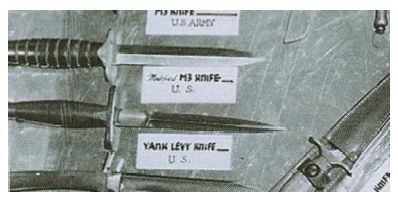
Case V42 Stiletto
More to come…
Impact and Other Weapons
“Daggers, blackjacks, knuckle-dusters, hammers, a roll of copper coins sewn into a
piece of canvas or strong linen, a sock with the foot full of sand; all are useful. These
are all weapons which will silently put a man out…-Guerrilla Warfare”
More to come…
© 2006 Phil Matthews –
thebristolbloke@yahoo.com 